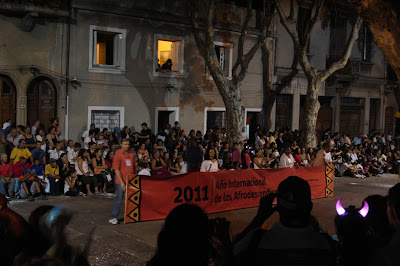Lucky for us, we happen to be living in Uruguay during Carnival. So, last night we decided to partake in the festivities and head downtown with our box-o-wine (like many Uruguayans)
for the “Desfile de las llamadas” which means parade of the calls. It is named this because back in the day, different carnival groups would call each other with their tambors (drums).
What we have learned about the origins of this tradition is that Africans were brought to Uruguay as slaves in the middle of the 18th century. Their dancing and music were prohibited and it wasn’t until the middle of the 19th century when slavery was abolished that the African music and dance combined with local tango dances and music to create what is called Candombe. So, once a year, Uruguayan people join together in the poorer neighborhoods of Palermo and Sur (where we spend lots of time) and celebrate the Candombe with drums and dance.
Once we got home, Todd couldn’t help but tell me what he thought about the parade, so… here’s his stream of consciousness:
Willingness to wiggle for an extended period of time is valued above all else. The willingness to wear very little is also very highly touted. Talent, rhythm, and dancing abilities are evidently NOT requirements and in fact might actually disqualify individuals from participating.
The value of the ability to wiggle is instilled in children before the ability to walk or talk and continues into their formative years and well beyond...
Huge flags, unsynchronized drums, glitter, lack of rhythm, elaborate colorful costumes…
Combination of jogging in place and Tahitian hula with a touchdown celebration dance and an occasional stutter/epileptic seizure punctuated with frequent looks downward elements of line dancing and salsa.
for the “Desfile de las llamadas” which means parade of the calls. It is named this because back in the day, different carnival groups would call each other with their tambors (drums).
What we have learned about the origins of this tradition is that Africans were brought to Uruguay as slaves in the middle of the 18th century. Their dancing and music were prohibited and it wasn’t until the middle of the 19th century when slavery was abolished that the African music and dance combined with local tango dances and music to create what is called Candombe. So, once a year, Uruguayan people join together in the poorer neighborhoods of Palermo and Sur (where we spend lots of time) and celebrate the Candombe with drums and dance.
Once we got home, Todd couldn’t help but tell me what he thought about the parade, so… here’s his stream of consciousness:
Willingness to wiggle for an extended period of time is valued above all else. The willingness to wear very little is also very highly touted. Talent, rhythm, and dancing abilities are evidently NOT requirements and in fact might actually disqualify individuals from participating.
The value of the ability to wiggle is instilled in children before the ability to walk or talk and continues into their formative years and well beyond...
Huge flags, unsynchronized drums, glitter, lack of rhythm, elaborate colorful costumes…
Combination of jogging in place and Tahitian hula with a touchdown celebration dance and an occasional stutter/epileptic seizure punctuated with frequent looks downward elements of line dancing and salsa.
I thought the parade was a lot of fun. It was a bit gross to see some of the women in their costumes (which were basically pasties for the top AND bottom), but the drums were great and the whole crowd was really into it. We also found one of the best mullets ever:
Before exiting the area, we stopped at a food cart serving chorizo sandwiches. Easily the best meat we’ve eaten in South America. Still not quite as good as a sausage dog from Costco, but it definitely hit the spot!








4 comments:
you guys are so rude!! how dare you look down upon someone elses culture.If it wasnt your cup of tea thats fine but please dont talk about their culture. What if they dont like how Americans celebrate?? would you appreciate it if they were as criticizing as u?? probably not.Plus the "nasty" hair styles u talk about are actually the hair that is in style for Uruguay, if you are uneducated enough to know that different countries have different styles then just shut up.
Thank you for your input. We have no shame in our description of our evening as it was just that... a description. Describing our perception of the different cultures we encounter is one of the main purposes of this blog. We have no other eyes but our own American ones through which to view it and can only describe it how we see it. If you don't like it, don't read it. As it turns out we and everyone we know WERE uneducated that the mullet could be popular anywhere and that is why we have dedicated so much time to describing this incredible fad. And, we have to be honest, to us mullets are nasty.
Fred in SoCal agrees that mullets suck! Take that, bad boy!
Post a Comment